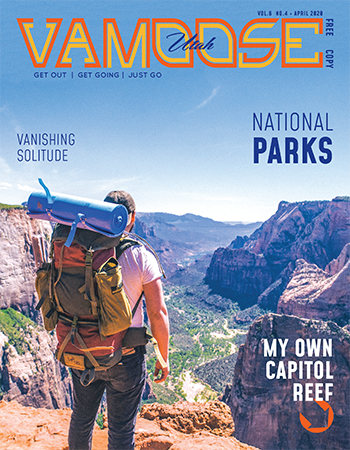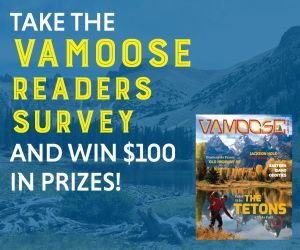Photography classes to help take your outdoor photography to the next level.
If being lost in the woods, awake at sunrise or traveling a lonely back road is the only excuse you need to grab your smart phone or camera and start snapping photos, you might be one of those incurable shutterbugs who needs to step it up and build on your camera knowledge. Consider upping your game by taking a class from the pros or joining a group that will get you out in the field to perfect your outdoor and adventure photography, landscape shots and portraiture.

Shoot the starry sky
Especially if you’re new to the craft, the “photog” lingo can be confusing. Speaking with local photographer Royce Bair gave me confidence I could surely crush this camera thing. Bair has a couple decades of experience on reserve and more than 60,000 Instagram followers who follow his passion for nightscape photography. One of his biggest loves? Bortle Class 1 skies—some of the darkest skies on Earth, the best for photographing planets and stars in motion.
To get to the place where he is now, Bair says he attended professional photo workshops around the country and continually submitted work (that was often accepted) to magazines and outlets he admired. He worked under his mentor Don Busath, of the iconic Busath Studio & Gardens in Salt Lake City, while still rocking a day job, the plight of many artists.
“About every five years, I have to reinvent myself to stay on the cutting edge,” he says. “I focus on doing something I’m passionate about, and that’s unique. That’s how I integrated the night sky, the Milky Way, and my landscapes.”
It seems to be working because his photography classes consistently fill up for both free and fee-based classes (ranging from $800-$1,700). In fact, his classes are rapidly filling up through 2017—a place many photographers want to be.
“Shooting the starry sky is unique, it brings it down to Mother Earth,” Bair says. “It’s a way to commune with the universe on an earthly level.” Bair’s shots are so ethereal that he is often asked if they are Photoshopped. Shooting photos at 3 a.m., he has the bleary eyes to prove he’s the person behind the lens. He recommends a DSLR (digital single lens reflex) and an equipment budget of at least $700 to $1,000 (or more) to capture nightscapes.
You can find more of Bair’s in-depth tips in his popular e-book (on Nightscaper.com), where he features other local photographers and his eclectic view of photography. It’s no surprise that this semi-retired photog does what he loves, while contributing to the community and getting serious recognition through social media and from KSL which is covering him in a mini documentary. If you’re lucky, you can grab a spot on his 2017 outings on the Grand Canyon River or Grand Teton solar eclipse (in mid-August).
Bair continually seeks to improve himself. I was even able to get him to reveal his favorite shooting spots, including Rush Valley, Mirror Lake and the West Desert. Want to perfect your nightscapes? “Get 20 to 50 miles outside of the city, 10 to 14 days before and after the full moon, between two hours after sunset and two hours before sunrise, to really capture the astronomical dusk,” says Bair. For more information on Bair’s classes, visit RoyceBair.com, NightScaper.com. You can find him on Instagram @roycebairphoto.

Vary your exposure
Whether you’re an amateur or a pro, photographers want to create emotional, edgy and thought-provoking shots. It’s an art for the highly creative, and one you will need to invest in if you want to take things to the next level. Asking a seasoned photog about their favorite lens is like asking a kid to name their favorite candy. Everyone has different tastes, and they often need a variety to be satisfied.
Ikon Republik, founder of Salt Lake City School of Photography, says, “One of the things I teach in my classes is to vary your exposure. When you learn how to expose correctly, you can add a lot of drama to your images.”
After shooting his first wedding at 14, he was hooked and has been shooting ever since. A few life changes propelled him to make the leap to make photography a full-time profession. Republik has a talent for capturing emotion in his natural portraits. He was inspired by ‘60s-era painter/photographer Saul Leiter to create his own mélange of realism that focuses on streets, nature and the residents of those places. Being a photographer gives him an excuse to appreciate the world at its highest level.
He’s putting together new outdoor workshops that will feature the imagery of Moab, Lake Powell and Iceland, the details of which will be announced later this year. Republik balks at the idea that there is no money in nature and landscape photography. “I know photographers who do really well selling their images. The trick is to do what they do. Most professional landscape photographers who are selling hundreds of thousands of prints shoot large-format film. If you want to make money, do what the people making money do,” he says.
He often finds himself seeking the perfect light of dusk in the setting of the Tetons, Moab, the salt flats and the Great Salt Lake. His specialty? Being creative, shooting models in stunning outdoor settings and teaching photography education courses for beginning photographers teaching them how to utilize their camera’s functions to better understand how aperture, shutter speed and lighting affect their photographs.
Republik connects with clients and other aspiring photogs through social media. He works hard to keep integrity in this competitive profession and to build value in the classes he offers—perfect for those looking for the basic essentials to those wanting a new perspective in natural portraits (priced between $600-$3,500).
“Meeting a few friends who have the same interests is a great start,” says Republik. Check for Republiks’s course offerings on Instagram @ikonrepublik and @slcphotschool or at SaltLakeCitySchoolOfPhotography.blogspot.com.
While the technicalities, settings and tricks of the trade tend to be the focus of photography classes, it’s often a treat to get to know the people behind the lenses. Joining the Wasatch Camera Club (WasatchCameraClub.com) and other local Meetup and Facebook groups provide not only a social outlet but an opportunity to learn from others. These groups often host field trips, conduct workshops and hold competitions to improve skills.
Night-sky photographer Royce Bair has been shooting photos on the road for nearly two decades. That’s where he has experienced the best moments of his life. “The in-between moments are the best pieces of real humanity,” Bair says.
From Bair, Republik and others, I’ve learned a few things: Capturing the right shot requires endless curiosity (and patience). Be prepared; timing is everything. We’re all inquisitive and want to explore beautiful landscapes in our own way.
I’ll see you out there (hidden behind my lens).



